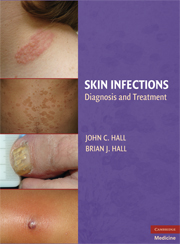Book contents
- Frontmatter
- Contents
- List of Contributors
- Acknowledgments
- INTRODUCTION
- TECHNIQUES IN DIAGNOSING DERMATOLOGIC MANIFESTATIONS OF INFECTIOUS DISEASES
- PRINCIPLES OF MANAGEMENT OF DERMATOLOGIC INFECTIONS IN THE SKIN
- PART 1 COMMON INFECTIONS
- PART II LESS COMMON INFECTIONS
- PART III INFECTIONS IN SELECTED ECOSYSTEMS
- PART IV INFECTIONS IN SELECTED PATIENT POPULATIONS
- 13 SKIN INFECTIONS IN HIV PATIENTS
- 14 INFECTIONS IN ORGAN TRANSPLANT PATIENTS
- 15 CANCER PATIENTS AND SKIN INFECTIONS
- 16 SKIN INFECTIONS IN PEDIATRIC PATIENTS
- 17 SKIN INFECTIONS IN THE ELDERLY
- 18 SKIN INFECTIONS IN ATHLETES
- 19 SKIN INFECTIONS IN DIABETES MELLITUS
- PART V INFECTIONS OF SPECIFIC SKIN-ASSOCIATED BODY SITES
- PART VI SPECIAL DISEASE CATEGORIES
- Index
16 - SKIN INFECTIONS IN PEDIATRIC PATIENTS
from PART IV - INFECTIONS IN SELECTED PATIENT POPULATIONS
Published online by Cambridge University Press: 08 January 2010
- Frontmatter
- Contents
- List of Contributors
- Acknowledgments
- INTRODUCTION
- TECHNIQUES IN DIAGNOSING DERMATOLOGIC MANIFESTATIONS OF INFECTIOUS DISEASES
- PRINCIPLES OF MANAGEMENT OF DERMATOLOGIC INFECTIONS IN THE SKIN
- PART 1 COMMON INFECTIONS
- PART II LESS COMMON INFECTIONS
- PART III INFECTIONS IN SELECTED ECOSYSTEMS
- PART IV INFECTIONS IN SELECTED PATIENT POPULATIONS
- 13 SKIN INFECTIONS IN HIV PATIENTS
- 14 INFECTIONS IN ORGAN TRANSPLANT PATIENTS
- 15 CANCER PATIENTS AND SKIN INFECTIONS
- 16 SKIN INFECTIONS IN PEDIATRIC PATIENTS
- 17 SKIN INFECTIONS IN THE ELDERLY
- 18 SKIN INFECTIONS IN ATHLETES
- 19 SKIN INFECTIONS IN DIABETES MELLITUS
- PART V INFECTIONS OF SPECIFIC SKIN-ASSOCIATED BODY SITES
- PART VI SPECIAL DISEASE CATEGORIES
- Index
Summary
INTRODUCTION
The topic of infectious diseases of the skin in children is quite broad, and an exhaustive review in a single chapter is not possible. Those infections with particular importance to pediatric patients will be emphasized.
HISTORY
Cutaneous infections are a major cause of morbidity in the pediatric population. It is estimated that one in five children presenting to their primary care provider have at least one skin complaint, and cutaneous infections represent the largest portion of these complaints. Certain cutaneous infections are unique to or more common in the pediatric population. Most recently, the rise of community-acquired methicillin-resistant staphylococcus aureus (CA-MRSA) and its spread in the pediatric population has highlighted the ever-changing nature of the battle against infectious disease. This chapter will review such conditions.
GRAM-POSITIVE BACTERIA
Impetigo
Impetigo is the most common bacterial skin infection in children, and has two different clinical presentations: nonbullous and bullous. Since the 1980s, nonbullous impetigo, which accounts for at least 70% of the cases, has been caused primarily by Staphylococcus aureus. Those infections caused by group A β-hemolytic streptococci (GABHS) cannot be distinguished clinically, but most frequently occur in preschool age children. Staphylococcus aureus is the cause of bullous impetigo, and it is most commonly caused by phage group 2, type 71.
Nonbullous impetigo presents as a small vesicle or pustule on sites of prior trauma.
- Type
- Chapter
- Information
- Skin InfectionsDiagnosis and Treatment, pp. 211 - 232Publisher: Cambridge University PressPrint publication year: 2009

